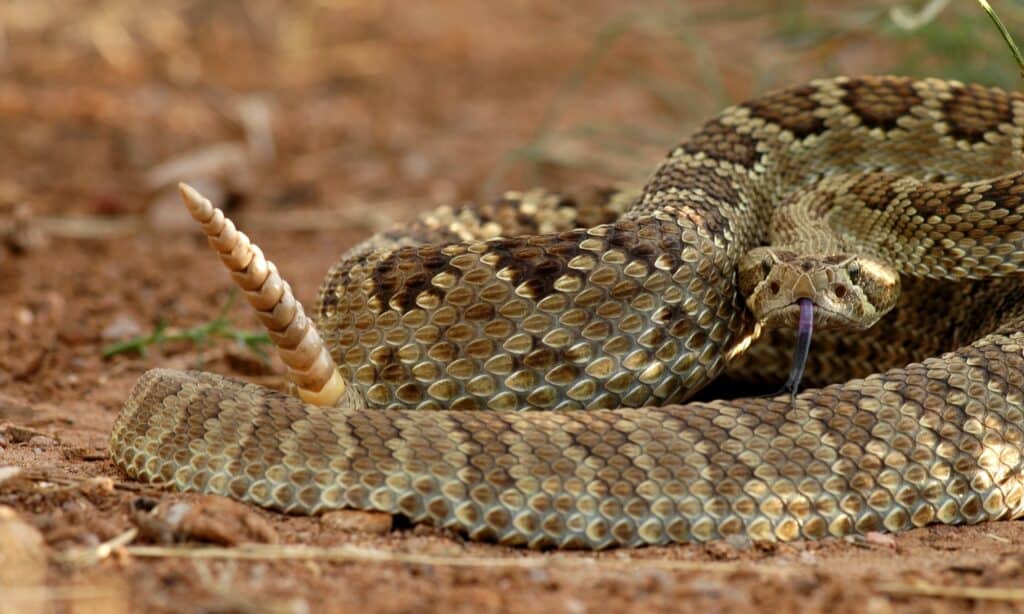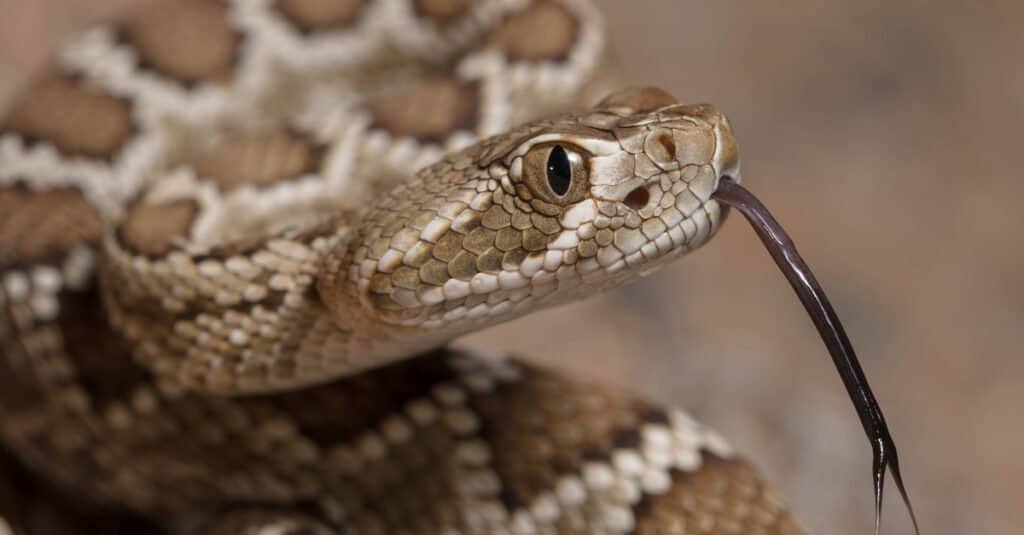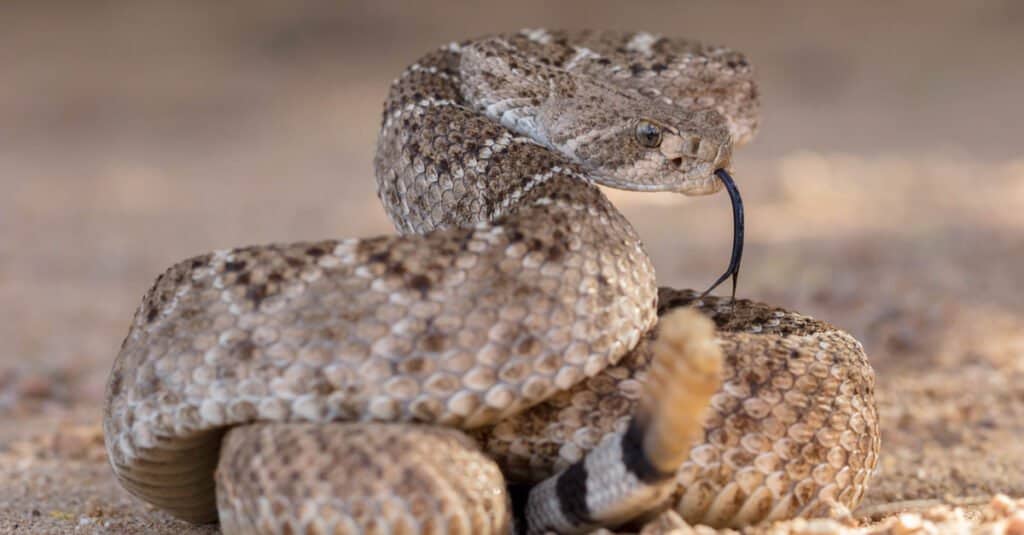Rattlesnakes are often heard, but not seen. The characteristic maraca sound of their rattle is enough to make any hiker freeze. But, do rattlesnakes come out at night? Like other species of snake, rattlesnakes are ectothermic, meaning they cannot control their own body temperatures. Because of this, they need the warmth of the sun to stay warm. But, that doesn’t mean that rattlesnakes only exist in the sunlight.
As members of the pit viper family, rattlesnakes are characterized by their deadly venom and ability to ‘see’ heat. There are 33 species of rattlesnake, and all of them present potential dangers to humans and other animals. Rattlesnakes are not aggressive, but accidental encounters account with them account for more snakebites in the United States than any other type of snake. Some of the most common species are the timber rattlesnake, prairie rattlesnake, and Mojave rattlesnake.
Here, we’ll learn more about how to identify a rattlesnake, and where they live. Then, we’ll take a closer look at the rattlesnake’s favorite times of day, and the best times of year for avoiding rattlesnakes. We’ll explore whether or not rattlesnakes come out at night. Finally, we’ll go over a few of the best ways to avoid encountering a rattlesnake, and what you should do if you do come upon one.
Rattlesnake Appearance

The Mojave rattlesnake is best known for its potent neurotoxic venom.
©iStock.com/Shoemcfly
When rattlesnakes come out, they’re often confused with other, less dangerous, types of snake, like bullsnakes. It’s important to recognize the differences between each type of snake. Bullsnakes are not venomous, though they do look similar to rattlesnakes. In fact, bullsnakes have actually evolved so that their looks mimic those of the rattlesnake, they’re trying to look more dangerous than they are.
Rattlesnakes are best identified by their rattles—a series of hollow, keratin segments located at the tips of their tails. When the rattlesnake wiggles its tail—they have special muscles just for rattling—the segments move against each other, creating the unique ‘rattling’ sound.
If the rattle isn’t enough for you, or if the snake is too young to have a developed rattle, then check out the head. All species of rattlesnake share a characteristic spade-shaped head. Gopher snakes and bullsnakes have sleeker, narrower heads, whereas rattlesnakes have heads that are very wide at the back, almost triangular. In addition to the head shape, rattlesnakes have a diamond pattern that repeats down the length of their body, though both bullsnakes have similar patterns.
Of course, head shape shouldn’t be the only thing you use to identify a rattlesnake because all snakes can spread their head out to look bigger.
Where Do You Find Rattlesnakes?
Before we determine whether or not rattlesnakes come out at night, let’s take a look at just where you might find a rattlesnake. Rattlesnakes are native to North America, though they’ve spread as far south as Argentina. They’re found in all major regions of the United States—including deserts, forests, swamps, shrublands, and grasslands. Rattlesnakes may seem like a species uniquely suited to the desert southwest, but they’re extremely adaptable to all different climates and landforms. They can even swim in both freshwater and saltwater.
When Do Rattlesnakes Come Out?

Rattlesnakes can use their heat-sensing organs to hunt even on pitch-black, moonless nights.
©Alexander Wong/Shutterstock.com
Rattlesnakes are most common from early spring to early fall. Like most reptiles, they don’t handle the cold well, and most brumate during the coldest months of the year. Brumation is very similar to hibernation in that brumating rattlesnakes go into a sort of stasis, though it’s not as extreme as hibernation. After spending the winter in a den—potentially with hundreds of other snakes—rattlesnakes come out to hunt and find mates.
During the spring, summer, and early fall months, rattlesnakes come out at all hours of the day and night. Yes, rattlesnakes do come out at night. In fact, because of their heat-sensing organs, they can see just as well at night as they can during the day. Rattlesnakes may come out at night for a variety of reasons, but the bottom line is that they hunt whenever, and wherever, the opportunities are best. If this means seeing the sun come up, they do it. And if it means staying up all night, well, rattlesnakes don’t mind that either. They adapt their behavior to suit the available prey.
Do Rattlesnakes Attack at Night?
Many people fear rattlesnakes and their bites, and that fear is not entirely irrational. A rattlesnake bite is a serious thing, and requires immediate medical attention, though fewer than two dozen people die on average every year from rattlesnake bites. However, if rattlesnakes come out at night, should you be worried about being bitten under the moonlight?
Rattlesnakes may be scary, but they’re not out to attack humans, no matter the time of day or night. They would much rather hide, or rattle a warning to stay away. However, accidents do happen, and if a human happens to get too close, rattlesnakes can, and will, strike to defend themselves. Nighttime bites are unlikely, but they do happen. Let’s take a look at the best ways to avoid rattlesnakes, both in the day and at night.
How to Avoid Rattlesnakes

The easiest way to avoid a rattlesnake is to stay on trails!
©Alexander Wong/Shutterstock.com
One of the easiest ways to avoid encountering a rattlesnake is to stay on the trail and keep your hands and feet within sight. Rattlesnakes come out at night and in the day, but they mostly stick close to cover. That means that humans shouldn’t go poking around under bushes or rocks unless they want to risk uncovering a rattlesnake.
You can also avoid rattlesnakes by making a little noise when you hike—the noise is likely to scare any rattlesnakes off before you ever get close enough for a bite. But, if you’re hiking along, and you hear the rattle of a nearby rattlesnake, what should you do?
Let’s take a look at the key steps you should take if you encounter a rattlesnake in the wild.
What Do You Do If You See a Rattlesnake?
If you see or hear a rattlesnake, the first thing to remember is not to approach it. Rattlesnakes are dangerous wild animals that can strike up to three feet away from their bodies. Slowly move away from the rattlesnake without making any sudden movements. If you have to pass the rattlesnake, make sure you give it a wide berth. And, keep children and pets especially far from rattlesnakes.
The photo featured at the top of this post is © Erin Donalson/Shutterstock.com
Discover the "Monster" Snake 5X Bigger than an Anaconda
Every day A-Z Animals sends out some of the most incredible facts in the world from our free newsletter. Want to discover the 10 most beautiful snakes in the world, a "snake island" where you're never more than 3 feet from danger, or a "monster" snake 5X larger than an anaconda? Then sign up right now and you'll start receiving our daily newsletter absolutely free.
Thank you for reading! Have some feedback for us? Contact the AZ Animals editorial team.






